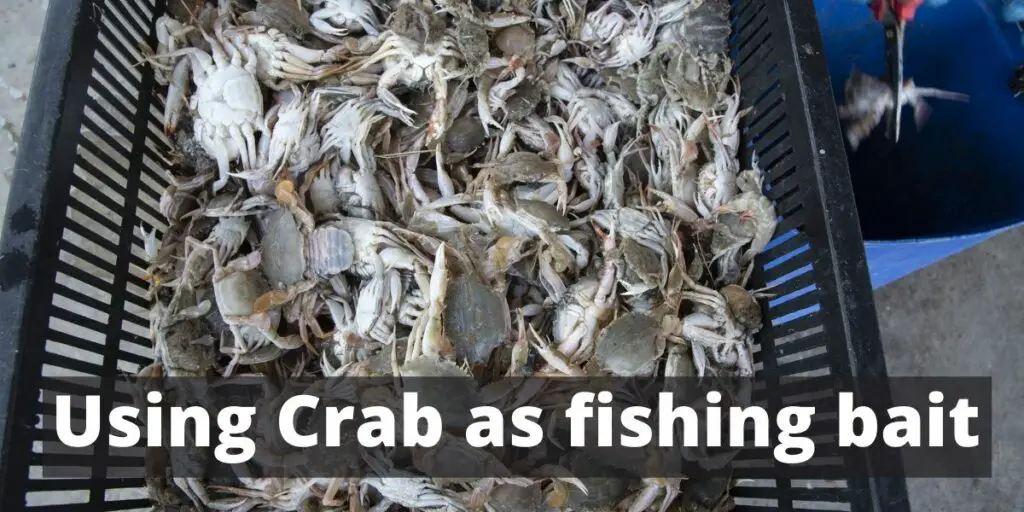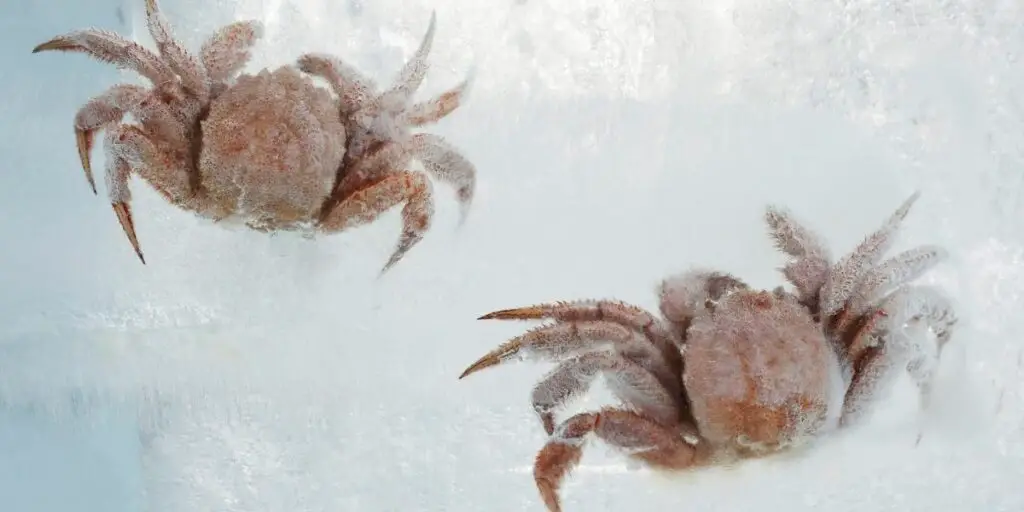
Although most people recognize crabs as seafood, you can also use them as bait for luring other fish.
There are several types of crabs – some are small that they can fit in your hand, while others are too big to fit in a bathtub.
Regardless of size, these creatures are a delicacy to game fish at specific points in their lives.
With crabs, you can use them to lure fish whether they are dead or alive.
If you intend to use them as live bait, break one of their back limbs and stick the hook on the bottom of the crab.
Ensure that you attach the hook’s pointy tip to a rubber band to prevent the bait from falling off.
Otherwise, peel the entire top shell and tail flap, and split the crab into two halves. Then, stick the hook through the middle of the meaty section and let it out through the bottom shell.
Read on to discover how you can use crabs as bait effectively and the pros and cons of using this approach.
Table of Contents
Preparing Crabs for Baiting Fish
The best time to use a crab as bait is when it starts blowing off its outer shell.
At this time, a crack appears on the side where the upper carapace separates from the lower body to reveal the soft tissue beneath the shell.
If the crack is invisible, break the crab’s leg segment.
Check if the tissue under the shell is solid and soft – if so, it’s ready to use as bait.
The next step is simple, as it involves removing the top shell.
This is known as popping because the crab extracts its old hard shell to reveal a soft tissue hinged to the eye sockets.

If the crab is in this stage, hook it to your fishing line as quickly as possible before the soft tissue starts hardening.
Alternatively, you can keep it in a freezer.
You can also control the rate at which the crab pops its shell by checking the amount of water it drinks.
The more water it consumes and the longer it swims, the shorter the peeling process.
Remember to exercise caution since a crab needs a continuous supply of seawater and damp conditions to survive.
Another method used to slow down the peeling process is by setting low temperatures on your refrigerator.
To do this, put a thermometer inside your fridge. This equipment helps you monitor and maintain temperatures a few degrees above the freezing point.
However, you need to be careful when decreasing the temperatures. If you lower it too much, the cold will kill the crabs.
Although some crabs can withstand extreme temperatures, they eventually die after prolonged exposure.
Because water is vital to extracting the hard shell, hydrating your carbs will speed up the peeling process.
That said, you need to hang around to separate the shell from the soft tissue to be used as bait.
Besides hydration, you can expedite the peeling process by placing the crabs in a bucket containing warm oxygenated water supplied using an air pump.
The most significant advantage of this method is that it’s fast. After a few minutes, you’ll be looking at crabs without their old hard shell.
It takes time and regular practice to know how many crabs you need for your fishing trip and how to keep them in the ideal condition for baiting.
Whether you are a novice or a seasoned angler, always ensure that you keep your crabs in a damp and cool environment.
If you want them to last long, keep them in a freezer.
Undressing a Crab
If you catch a crab as it starts to harden after peeling its shell, you must remove the remaining shell in its entirety before using it to lure fish.
Pierce between the eye sockets to kill the crab, then break of the claws and legs located on its first segment.
Next, remove the shell on all sides and separate it from the soft tissue.
After removing the shell, you are likely to spot some translucent white shell in the lower segments. If so, use tweezers to remove them.
You should also pull out the eye sockets and the mouth.
The final step involves removing the crab’s lungs, and this is done by tearing it apart from both sides.
Crab legs are also effective when used as bait. What’s more, you can cut the limb into smaller segments.
This is a smart way of knowing if the crab was ready for peeling, as the legs should break into smaller pieces without extra effort.
If not, you probably chose a crab that isn’t ready to be hooked to a fishing line.
Preserving Crab for Baiting
As mentioned earlier, freezing slows down the peeling process in crabs.
If you’re freezing crabs without their old hard shells, you must remove the new lung tissue.
It is essential to handle frozen crabs like human food. Avoid using crabs that die from natural causes.
This is because they decompose and start producing toxins shortly after death. These toxins are easily detectable by fish.

The best coolant to use when preserving crabs is liquid nitrogen. However, it isn’t accessible to many anglers.
A cheaper alternative involves raising the crabs using running water, followed by drying them out in the sun for a few minutes.
Then, place the peeled crabs on a pre-frozen thin sheet of metal for two to three hours.
Once the crabs are dry, wrap them using a cling film or aluminium foil.
Ensure that the wrapping is very tight, as this produces an insulating effect, especially if several crabs are stacked together.
How to Fish with Crabs
The effectiveness of crab as bait mostly depends on the species of fish you are targeting.
Generally, smaller crabs effectively catch small fish, while larger species work well in luring bigger fish.
Here are the different types of crabs, how to catch them, and the kinds of fish they are effective at luring.
Fiddler Crabs
Fiddler crabs mostly live near backcountry creeks, muddy shorelines, and oyster creeks.
They are ideal for capturing permit, pompano, redfish, and sheepshead.
If you want to catch fiddler crabs, use plywood strips to make a funnel, then place supporting sticks near the edge of the water body.
Sink an empty bucket into the sand at the smaller end of the funnel, and then wait for the crabs to fall into your trap.
Black Mangrove Crabs
As the name suggests, these live near mangrove trees. They are small, with the largest being as big as a 50 cent coin.
This makes them suited for capturing pompano and sheepshead.
The best way to capture black mangrove crabs is by placing bait next to mangrove roots or seawalls when the tide is low.
The bait should have cardboard soaked with salty water on top of it. The saltiness ensures that the crabs stay put, even after they eat the bait.
Blue Crabs
Blue crabs are readily available and easier to catch than other types of crabs.
All you need to lure them is a piece of chicken or mullet.
Small blue crabs are arguably one of the most effective live baits. They are the favourite food for cobia, drum, and redfish.
You can also increase your haul by cutting larger crabs into smaller pieces, especially if you’re targeting big black drum and redfish.
Hermit Crabs
Hermit crabs are abundant in the tropics and a favourite for permit.
Because of their sluggishness, they are easy to catch along beaches and coral edges.
Sand Fleas
Also known as mole crabs, sand fleas can help you capture pompano and snook.
You can catch them easily by sieving the sand at your local beach. Sand flea rakes are also available in most bait shops.
Pros of Using Crabs as Bait
The following are the advantages of using crabs as bait.
- Accessibility – crabs are among the most abundant sea creatures worldwide. If you intend to use them as bait, you can get them at your local beach or purchase them from a bait shop.
- Variety – as seen above, there are several types of crabs, each of which has its best use case. Your choice always depends on the kind of fish you intend to capture.
- Versatility – you can use crabs as bait, whether dead or alive. This means that you don’t have to worry if you plan to go fishing in inland water bodies where most crab species can’t survive.
- Hardiness – most crabs can withstand cold temperatures when being frozen, albeit for a short while. This helps you keep them alive for longer if you plan to transport them to another water body for baiting.
Cons of Using Crab as Bait
- Riskiness – crabs have claws that can bite, causing you some pain. Luckily, most of them aren’t poisonous.
- Reduced effectiveness when dead – the erratic movement of live crabs helps attract fish into your trap. This isn’t the case when you use dead crabs, as they can’t move.
Final Thoughts
If you’re thinking of trying something new on your next fishing trip, you might want to consider using crabs as bait.
They are available on most beaches and will allow you to catch a variety of fish species. For the best results, use them as live bait.
Lastly, ensure that you handle them carefully when removing the shell. Although it isn’t poisonous, a bite from its claws can cause some discomfort.